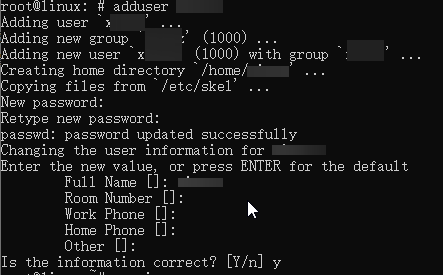Adding a new user with sudo privileges in Debian system
Publish: 2023-05-06 | Modify: 2023-05-06
Introduction
For security reasons, when setting up a new server, it is common practice to create a new user with sudo privileges and disable the root user. This article outlines and shares the steps to accomplish this on a Debian system.

Adding a New User
Simply execute the following command:
# Replace 'newuser' with your desired username
sudo adduser newuserThe adduser command is specific to Debian-based systems (including Ubuntu) and is not present in Redhat-based systems. This command will automatically create the user, user group, and home directory, and prompt for additional information such as the user's password and name.

Granting Sudo Privileges
Some Debian systems may not have the sudo command installed by default. You can install it by executing the following command (requires root user privileges):
apt-get install sudoOnce installed, execute the following command (requires root user privileges) to add the new user to the sudo group, granting them administrative privileges:
# Replace 'newuser' with the username from the previous step
usermod -aG sudo newuserTesting
Switch to the newuser and test if sudo is functioning correctly:
# Switch to newuser
su - newuser
# Test sudo privileges, if no error is displayed, it is working correctly
sudo pwdConclusion
Creating a new user and granting sudo privileges on a Debian-based system is straightforward. With just a few commands, you can complete the process without the need to modify configuration files, making it more convenient compared to Redhat-based systems.
Comments

xiaoz
I come from China and I am a freelancer. I specialize in Linux operations, PHP, Golang, and front-end development. I have developed open-source projects such as Zdir, ImgURL, CCAA, and OneNav.
Random article
- [AD] RAKsmart Data Center Defense Upgrade up to 300G, Free 7-day 50G Attack Testing
- Enhanced Tool for Windows Console (cmd): cmder
- Nginx Reverse Proxy + Thumbor Image Cropping: Enhancing Nginx's Image Cropping Support
- WordPress Output Menu Structure with LayUI Styles
- Implementing WordPress Article Like Functionality Using Code
- Free DNS Resolution Services for International Domains
- [AD] Asia.Cloud Hong Kong VPS, Up to 60% off for New Users, Three Network Direct Connection, Windows Optional
- Multi-functional File Sharing Program Zdir 4.1.2 Update, Last Day of Summer 50% Off Promotion
- One-click Installation of Seafile on CentOS 7 to Build Private Cloud Storage
- Comprehensive Guide to Opening an Account and Applying for a Debit Card at OCBC Singapore